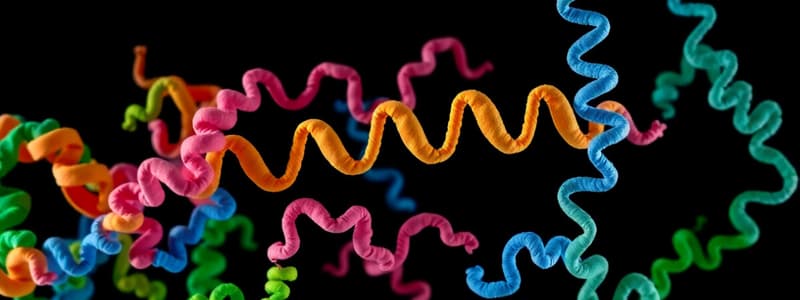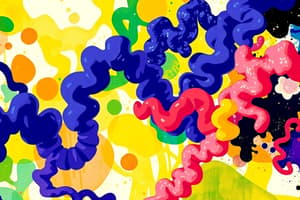Podcast
Questions and Answers
What is the significance of the colloidal nature of proteins in biological systems?
What is the significance of the colloidal nature of proteins in biological systems?
- They have a heavier density than water, allowing them to float.
- They can form stable suspensions in solutions, affecting biochemical interactions. (correct)
- They convert into gas when heated, leading to energy release.
- They are primarily used for energy storage.
Which of the following classifications of proteins is distinctly characterized by their structural role for support and protection?
Which of the following classifications of proteins is distinctly characterized by their structural role for support and protection?
- Catalytic proteins
- Genetic proteins
- Fibrous proteins (correct)
- Transport proteins
Which type of proteins is known to perform metabolic regulation and maintain proper pH levels within cells?
Which type of proteins is known to perform metabolic regulation and maintain proper pH levels within cells?
- Regulatory proteins (correct)
- Defensive proteins
- Transport proteins
- Structural proteins
What defines the classification of proteins as complete proteins?
What defines the classification of proteins as complete proteins?
What is characteristic of globular proteins compared to fibrous proteins?
What is characteristic of globular proteins compared to fibrous proteins?
What is the primary significance of the tertiary structure of a protein?
What is the primary significance of the tertiary structure of a protein?
Which interactions help stabilize the quaternary structure of proteins?
Which interactions help stabilize the quaternary structure of proteins?
In sickle cell anemia, how does the substitution of glutamic acid by valine affect hemoglobin?
In sickle cell anemia, how does the substitution of glutamic acid by valine affect hemoglobin?
How many oxygen molecules can each hemoglobin molecule carry?
How many oxygen molecules can each hemoglobin molecule carry?
Which of the following statements is true regarding simple proteins?
Which of the following statements is true regarding simple proteins?
What is the relationship between primary structure and protein function?
What is the relationship between primary structure and protein function?
What does the term 'native conformation' refer to in proteins?
What does the term 'native conformation' refer to in proteins?
What is the primary function of proteins in living cells?
What is the primary function of proteins in living cells?
Which of the following statements about amino acids is true?
Which of the following statements about amino acids is true?
What determines the three-dimensional structure of a protein?
What determines the three-dimensional structure of a protein?
Which amino acid is incorporated through special translation mechanisms?
Which amino acid is incorporated through special translation mechanisms?
What characteristic is shared by all standard amino acids?
What characteristic is shared by all standard amino acids?
What is the significance of pyrrolysine in relation to amino acids?
What is the significance of pyrrolysine in relation to amino acids?
Which group is attached to the α-carbon of all common amino acids except glycine?
Which group is attached to the α-carbon of all common amino acids except glycine?
What does the term 'proteogenic' refer to in amino acids?
What does the term 'proteogenic' refer to in amino acids?
Which characteristic ensures that amino acids can participate in peptide bond formation?
Which characteristic ensures that amino acids can participate in peptide bond formation?
Which of the following amino acids is not coded in the standard genetic code?
Which of the following amino acids is not coded in the standard genetic code?
Flashcards
Tertiary Structure (3°)
Tertiary Structure (3°)
The three-dimensional folded shape of a single polypeptide chain. It's the active conformation of a protein crucial for its function.
Quaternary Structure (4°)
Quaternary Structure (4°)
Refers to the arrangement of multiple polypeptide chains (subunits) in a protein complex. Holds the subunits together using various interactions.
Native Conformation
Native Conformation
The native conformation of a protein is its natural biological form. It's essential for the protein's function.
Structure-Function Relationship
Structure-Function Relationship
Signup and view all the flashcards
Single Amino Acid Substitution
Single Amino Acid Substitution
Signup and view all the flashcards
Sickle Cell Anemia
Sickle Cell Anemia
Signup and view all the flashcards
Simple Proteins
Simple Proteins
Signup and view all the flashcards
Primary Derived Proteins
Primary Derived Proteins
Signup and view all the flashcards
Secondary Derived Proteins
Secondary Derived Proteins
Signup and view all the flashcards
Globular Proteins
Globular Proteins
Signup and view all the flashcards
Fibrous Proteins
Fibrous Proteins
Signup and view all the flashcards
Complete Proteins
Complete Proteins
Signup and view all the flashcards
Proteins
Proteins
Signup and view all the flashcards
Proteins: Chemical Composition
Proteins: Chemical Composition
Signup and view all the flashcards
Proteins: Structure
Proteins: Structure
Signup and view all the flashcards
Proteins: Uniqueness
Proteins: Uniqueness
Signup and view all the flashcards
Protein Building Blocks: Amino Acids
Protein Building Blocks: Amino Acids
Signup and view all the flashcards
Proteogenic Amino Acids
Proteogenic Amino Acids
Signup and view all the flashcards
Standard Amino Acids in Humans
Standard Amino Acids in Humans
Signup and view all the flashcards
α-Carbon and Side Chain
α-Carbon and Side Chain
Signup and view all the flashcards
Glycine: Unique Amino Acid
Glycine: Unique Amino Acid
Signup and view all the flashcards
Free Groups: Essential for Peptide Bonds
Free Groups: Essential for Peptide Bonds
Signup and view all the flashcards
Study Notes
Proteins
- Proteins are the most abundant macromolecules in living cells.
- These are nitrogenous organic compounds primarily composed of carbon, hydrogen, oxygen, and nitrogen.
- In 1838, the term protein was derived from the Greek word "protos," meaning "primary" or "first."
- The basic monomers of proteins are L-α-amino acids linked together by strong covalent peptide bonds.
- Each protein has a unique sequence of amino acids that determines its three-dimensional structure and its specific biological function.
- There are approximately 300 naturally occurring types of amino acids, but only 21 are involved in the formation of proteins—also called primary, proteogenic, standard or basic amino acids.
- The rest are non-standard amino acids that are not used in the human body.
- All 21 amino acids are biologically crucial, and their deficiency would interfere with protein synthesis.
- The a–form of an amino acid is characterized by an amino group (-NH2) attached to a carbon atom (C) adjacent to a carboxyl group (-COOH).
- Except for glycine, every amino acid has four different groups attached to a-carbon.
- All amino acids possess a free a-amino (-NH2) group and a free α-carboxyl (-COOH) group.
- Proteins have the L-configuration, which is defined by levorotatory counterclockwise behavior based on their optical activity.
- Proteins form peptide bonds via the carboxyl group of one free amino acid and the amino group of another. This process is a dehydration reaction, releasing water.
- Amino acids exhibit varying properties due to differences in their side chains (R groups).
- Amino acid properties include shape, size, charge, hydrogen-bonding capacity, hydrophobic characters, and chemical reactivity.
- Amino acids can be classified based on polarity and chemical nature. Polarities of R-groups can be hydrophobic or hydrophilic.
Levels of Protein Structure
- Proteins have four levels of structural organization
- Primary: The amino acid sequence of a polypeptide chain (order). The backbone, [-N-Ca(R)-C(O)-] is repetitive. Only the R group side-chains vary.
- Secondary: Folded structures within a polypeptide chain. Includes alpha helices and beta-pleated sheets. Hydrogen bonds keep the secondary structures shaped.
- Tertiary: The final three-dimensional shape of a protein. Hydrophobic interactions between R groups primarily drive the structures. Other interactions such as ionic interactions, hydrogen bonding and covalent bonding via disulfide bridges create the final protein shape,
- Quaternary: The association of multiple polypeptide chains to form a functional protein complex. Can involve hydrophobic interactions, ionic interactions, hydrogen bonding, and covalent bonding (disulfide bridges).
Classification of Proteins
- Simple: Contain only amino acids. Examples include albumin, globulin, globin, prolamines, histones, and protamines.
- Conjugated: Contain a non-protein part (prosthetic group). Examples include nucleoproteins, mucoproteins, glycoproteins, lipoproteins, proteolipids, hemoproteins, and metalloproteins.
Properties of Proteins
- Colloidal particles: Exist as colloidal particles, heavier than water in size varying from 5–100 µm.
- Osmotic pressure: Protein concentration influences osmotic pressure.
- Oncotic pressure: Generated by large proteins in blood plasma (e.g., albumin). Maintains fluid balance.
- Solubility: Globular proteins are generally more soluble than fibrous proteins, Smaller molecules generally more soluble than larger.
- Shape: Proteins like insulin are globular (sphere-like), albumin is oval-shaped, and fibrinogen molecules are elongated.
Amphoteric Nature & Isoelectric Point (pI)
- Amphoteric: act as both acids and bases due to amino and carboxyl groups
- Isoelectric Point (pI): The pH at which a protein is electrically neutral (net charge equals zero). This is crucial for protein solubility and behavior during electrophoresis.
Precipitation of Proteins
- Factors affecting protein stability include charges, hydration of proteins
- Techniques for protein precipitation include: Salting out (using neutral salts). • Isoelectric precipitation (at specific pH values). • Precipitation by organic solvents. • Precipitation by heavy metal ions and alkaloidal reagents.
Denaturation of Proteins
- Denaturation: Protein unfolding caused by disruptive interactions (ionic bonds, hydrogen bonds, hydrophobic interactions), which alters its shape and function.
- Factors leading to denaturation: heat, changes in pH, exposure to chemicals, mechanical stress.
- Denaturation can be reversible or irreversible
Digestion & Absorption of Dietary Proteins
- Digestion: Process of breaking down proteins into smaller peptides and amino acids.
- Locations and mechanisms of digestion include the mouth, stomach, small intestine, through enzymatic cleavage by pepsin and others. The process usually involves several steps culminating in single amino acids or small peptides.
- Absorption: Absorption of amino acids and short peptides into the bloodstream via active transport.
- Different types of proteins require different types of enzymatic digestion, which is essential for the overall absorption of essential amino acids.
Metabolism of Proteins
- Utilization of amino acids for energy, synthesis of new proteins, or the creation of other molecules.
- Catabolism of proteins into amino acids when glucose or fat is not available as energy sources
- Catabolism: a process where the body takes proteins and transforms them into energy through the use of various processes.
- The process culminates in urea synthesis and excretion in the urine
- Synthesis or further transformation and incorporation of amino acids into specific metabolites such as hormones, neurotransmitters and other compounds.
Studying That Suits You
Use AI to generate personalized quizzes and flashcards to suit your learning preferences.




